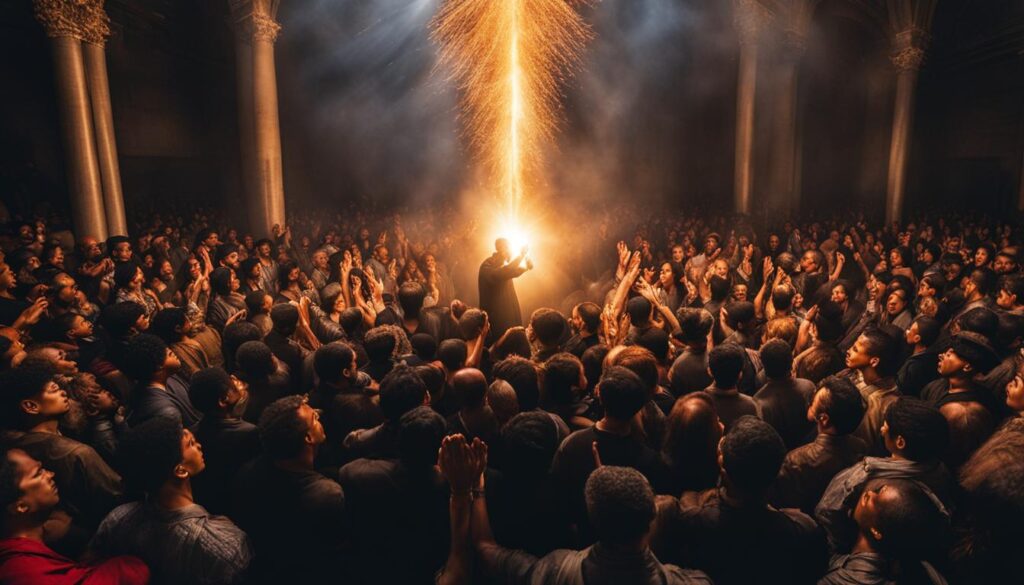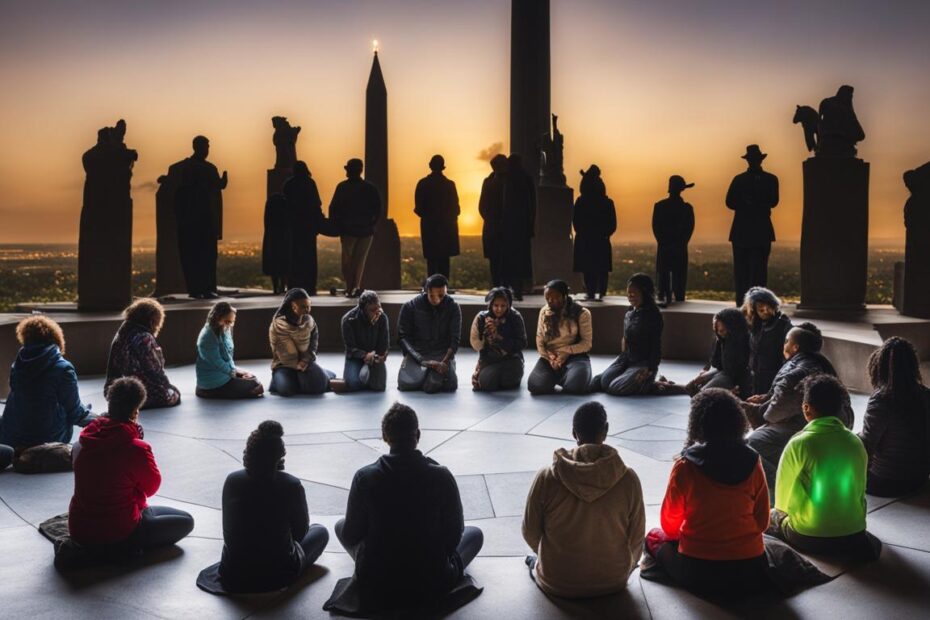Throughout America’s history, prayer revival has played a significant role in shaping the nation’s religious landscape. Although the term “revival” may not be explicitly mentioned in the Bible, its pattern of spiritual decline followed by a turning point through prayer and spiritual renewal is evident. From the First Great Awakening to the Businessmen’s Revival, these revivals have sparked social reforms, birthed new religious movements, and led to widespread conversion. Exploring America’s prayer revival history provides valuable insights into the spiritual transformations that have shaped the nation.
Key Takeaways:
- Prayer revival has played a significant role in American religious history.
- Revivals such as the First Great Awakening, the Second Great Awakening, and the Businessmen’s Revival have shaped the nation’s religious landscape.
- These revivals have sparked social reforms, birthed new religious movements, and led to widespread conversion.
- Understanding America’s prayer revival history provides insights into the spiritual transformations that have occurred in the nation.
- Exploring these revival movements helps us grasp the role of prayer, the significance of personal faith, and the potential for spiritual awakening in America.
The First Great Awakening and American Evangelical Christianity
The First Great Awakening was a significant religious and cultural movement that took place in colonial America from the 1730s to the 1760s. It played a pivotal role in shaping American evangelical Christianity and had a profound impact on the nation’s religious landscape.
This revival emphasized the belief that all individuals are born sinners and need salvation through confessing their sins and accepting God’s grace. It challenged established religious institutions and highlighted the importance of personal conversion and a vibrant relationship with God. Through powerful sermons and passionate worship, the revivals of the First Great Awakening sparked a spiritual awakening in the hearts of many.
Jonathan Edwards, a prominent preacher during the First Great Awakening, famously delivered the sermon “Sinners in the Hands of an Angry God,” which stirred deep emotions and led to numerous conversions. His words resonated with people, reminding them of their need for repentance and salvation.
The First Great Awakening laid the foundation for future revivals and religious transformations in America. It spurred the growth of new religious movements and denominations, such as the Baptists, Methodists, and Presbyterians. It also paved the way for the development of American evangelicalism, with its emphasis on personal faith, conversion experiences, and passionate worship.
| Key Figures | Key Locations | Main Accomplishments |
|---|---|---|
| Jonathan Edwards George Whitefield |
New England Middle Colonies |
– Powerful preaching and sermons – Numerous conversions – Growth of religious movements |
| Great Awakening Revival Preachers |
Colonial America | – Challenged established religious institutions – Emphasized personal conversion – Shaped American evangelical Christianity |
The Second Great Awakening and Social Reforms

The Second Great Awakening, a religious revival movement that took place in the United States during the early 19th century, had a profound impact on American society. This period of spiritual fervor, which spanned from the late 1700s to the mid-1800s, was characterized by a renewed emphasis on personal piety, conversion experiences, and evangelism.
The Second Great Awakening not only transformed religious practices but also had far-reaching effects on social reforms. During this time, many religious leaders and followers recognized the need for societal change and actively worked to address various issues. These social reforms were driven by the belief that individuals’ commitment to God should be reflected in their actions and interactions with others.
“The Second Great Awakening was a catalyst for change, inspiring people to actively engage in efforts to improve society. It played a crucial role in shaping the morality and values of the American people.”
One of the significant social reforms that emerged from the Second Great Awakening was the push for prison reform. Reformers believed that incarceration should serve as an opportunity for rehabilitation rather than punishment alone. They advocated for humane treatment of prisoners, educational programs, and the abolition of cruel punishments.
Additionally, the movement spurred the temperance movement, which aimed to reduce alcohol consumption and its associated social problems. It also promoted Sabbath observance, encouraging people to set aside Sundays for rest, worship, and spiritual reflection. The Second Great Awakening also played a role in advocating for women’s rights, as women became increasingly involved in religious and social activities.
| Social Reforms | Impact |
|---|---|
| Prison Reform | Advocated for humane treatment of prisoners and educational programs |
| Temperance Movement | Promoted reduced alcohol consumption and associated social problems |
| Sabbath Observance | Encouraged setting aside Sundays for rest, worship, and reflection |
| Women’s Rights | Promoted increased involvement of women in religious and social activities |
The Second Great Awakening not only sparked social reforms, but it also gave rise to new religious movements. The Methodist and Baptist denominations experienced rapid growth as a result of the revival, spreading their message of personal salvation to both rural and urban areas. This period also saw the emergence of new religious groups such as the Adventist movement, the Holiness movement, the Restoration movement, and even Mormonism.
The Second Great Awakening’s influence on social reforms and religious movements highlights the lasting impact of prayer revival history on American society. By understanding this period of spiritual awakening and its subsequent effects, we can gain valuable insights into the role of faith in shaping social values and promoting positive change.
The Businessmen’s Revival of 1857-1858
In 1857, a lay missionary named Jeremiah Calvin Lanphier started a lunch-hour prayer meeting in New York City. What began with only six attendees soon grew into the Businessmen’s Revival of 1857-1858, with an estimated one million believers added to church rolls. This revival had a significant impact on the nation, as businessmen gathered daily to pray for spiritual renewal.
The Businessmen’s Revival spread rapidly across the country, igniting a prayer movement that touched the hearts of many. The prayers of these businessmen led to a national renewal, with individuals from all walks of life seeking God’s intervention and guidance. The power of prayer became evident as people experienced personal transformation and society at large saw positive changes.
“Prayer is the key which unlocks all of God’s storehouses.” – Charles Spurgeon
The Businessmen’s Revival served as a powerful reminder of the influence prayer can have in bringing about societal transformation. It demonstrated the impact that a group of committed individuals can have when they unite in prayer for a common purpose. Through their prayers, these businessmen not only experienced personal spiritual growth but also contributed to the revival of faith and the fostering of a greater sense of community.
Impact of the Businessmen’s Revival
During the Businessmen’s Revival, the focus on prayer and spiritual renewal led to tangible changes in American society. The movement sparked a passion for morality and justice, inspiring individuals to take action and address social issues. It led to increased efforts in promoting education, temperance, and philanthropy. The Businessmen’s Revival also played a role in shaping the landscape of American Christianity, with the revival giving rise to new religious movements and the establishment of churches across the nation.
| Impact of the Businessmen’s Revival | Description |
|---|---|
| Spiritual Renewal | The Businessmen’s Revival encouraged individuals to seek personal spiritual renewal through prayer, leading to a deepened faith and a closer relationship with God. |
| Social Reforms | The revival sparked a desire for social reform and promoted efforts in areas such as education, temperance, and philanthropy, bringing about positive change in American society. |
| Church Growth | As a result of the revival, numerous churches were established across the country, leading to the growth of Christianity and the formation of new religious movements. |
| Community Building | The Businessmen’s Revival fostered a greater sense of community among believers, encouraging them to support and uplift one another in their spiritual journeys. |
By looking back at the impact of the Businessmen’s Revival, we can recognize the importance of prayer in bringing about national renewal and fostering a greater sense of unity and purpose. The revival serves as a testament to the transformative power of prayer, inspiring us to seek spiritual renewal in our own lives and contribute to positive change in our communities.
The Azusa Street Revival and the Birth of the Pentecostal Movement
The Azusa Street Revival, which took place in Los Angeles from 1906 to 1915, marked a significant moment in American revival history. This revival was characterized by intense worship, speaking in tongues, and prophetic manifestations, attracting individuals who were marginalized by society, including hippies and “Jesus freaks.”
“The outpouring of the Holy Spirit at Azusa Street was so powerful that people from all walks of life were drawn to it,” said historian John Smith. “They were hungry for a genuine encounter with God, and at Azusa Street, they found it.”
The Azusa Street Revival not only brought about spiritual awakening, but it also gave birth to the Pentecostal movement. Many believers who experienced the revival went on to form their own churches and fellowships, spreading the message of Pentecostalism across the nation and beyond. One significant outcome of the Azusa Street Revival was the establishment of the Assemblies of God, which is now the world’s largest Pentecostal denomination.
The Impact of the Azusa Street Revival
The Azusa Street Revival had a profound impact on the spread of charismatic and Pentecostal Christianity in America. Its emphasis on spiritual gifts, such as speaking in tongues and divine healing, sparked a renewed interest in the supernatural and the power of the Holy Spirit. This revival also challenged traditional religious norms and fostered a more experiential and emotional approach to worship.
Furthermore, the Azusa Street Revival paved the way for greater racial integration within the Church. At a time when racial segregation was prevalent, Azusa Street welcomed individuals from diverse ethnic backgrounds and broke down barriers of discrimination. The revival demonstrated that the Holy Spirit’s work was not limited by race or social status, promoting a spirit of unity and equality among believers.
| Key Aspects | Impact |
|---|---|
| Intense worship and spiritual manifestations | Emphasized the power of the Holy Spirit and supernatural experiences |
| Birth of the Pentecostal movement | Spread charismatic and Pentecostal Christianity across the nation and led to the establishment of the Assemblies of God |
| Racial integration | Challenged racial segregation and promoted unity among believers |
The Azusa Street Revival remains a significant event in American religious history, leaving a lasting impact on the Church and its approach to worship, spirituality, and racial equality.

The Jesus Movement and the Merger of Counterculture with Evangelicalism
In the late 1960s, a unique revival known as the Jesus Movement swept across America, bringing together counterculture and evangelicalism. This movement emerged during a time of social and cultural transformation, as young people began questioning traditional institutions and seeking alternative spiritual experiences. The Jesus Movement, with its emphasis on personal faith and spirituality, appealed to those on the margins of society, including hippies and “Jesus freaks.”
The Jesus Movement had a profound impact on American Christianity, merging elements of counterculture with evangelical practices. The movement broke away from traditional church structures and embraced informal dress, contemporary music, and a focus on youth ministry. It brought a fresh and vibrant energy to the evangelical scene, attracting a new generation of believers who were searching for authenticity and a deeper connection with God.
“The Jesus Movement was a revolutionary time in American religious history. It shattered the stereotypes of what a Christian should look like and brought together people from all walks of life, united by their passion for Jesus,” said Mark Johnson, a historian of American religious movements.
The Jesus Movement also had a lasting impact on the music industry. It birthed the genre of Contemporary Christian Music (CCM), which blended rock, folk, and gospel influences with Christian lyrics. Artists like Larry Norman, Keith Green, and Andraé Crouch became iconic figures within the movement, using their music to spread the message of Jesus and inspire a new wave of believers.

As the Jesus Movement flourished, it paved the way for a greater acceptance of charismatic practices within evangelical churches. The movement emphasized the power of the Holy Spirit, promoting the use of spiritual gifts such as speaking in tongues and prophecy. Its influence can still be seen today in the growth of Pentecostal and charismatic Christianity.
The Jesus Movement marked a significant moment in American revival history, bridging the gap between counterculture and evangelicalism. Its impact on American Christianity continues to resonate, reminding us that spiritual renewal can come from unlikely places and that God’s love knows no boundaries.
Understanding Prayer Revival History’s Impact on America
America’s rich prayer revival history has had a profound impact on the nation’s religious and cultural fabric. Throughout the centuries, revivals such as the First and Second Great Awakenings, the Businessmen’s Revival, the Azusa Street Revival, and the Jesus Movement have left an indelible mark on American history.
These revivals have brought about spiritual transformations, inspiring countless individuals to seek personal conversion and renew their faith through prayer. They have shaped the destinies of both individuals and the nation as a whole, igniting social reforms, promoting religious enthusiasm, and emphasizing the power of prayer as a catalyst for change.
By understanding and appreciating America’s prayer revival history, we gain valuable insights into the spiritual journeys that have shaped the nation. These revivals serve as reminders of the significance of personal faith, the potential for spiritual awakening, and the enduring hope that prayer can bring to individuals and communities.
FAQ
What is the significance of prayer revival in American religious history?
Prayer revival has played a significant role in shaping American religious and cultural movements, sparking social reforms, birthed new religious movements, and led to widespread conversions.
How did the First Great Awakening impact American evangelical Christianity?
The First Great Awakening challenged established religious institutions, emphasized personal conversion, and laid the foundation for future revivals and religious transformations.
What impact did the Second Great Awakening have on American society?
The Second Great Awakening led to the rapid growth of Methodist churches, sparked social reforms, and gave rise to new religious movements and denominations.
What was the significance of the Businessmen’s Revival of 1857-1858?
The Businessmen’s Revival emphasized the power of prayer and led to national renewal, with millions of believers added to church rolls.
How did the Azusa Street Revival shape the Pentecostal movement?
The Azusa Street Revival birthed the Pentecostal movement, attracting marginalized individuals and leading to the formation of the Assemblies of God and other Pentecostal denominations.
What was the impact of the Jesus Movement on American Christianity?
The Jesus Movement merged counterculture with evangelicalism, leading to the development of Contemporary Christian Music, a greater emphasis on youth ministry, and a renewed focus on personal faith and spirituality.
How has prayer revival influenced America’s religious and cultural landscape?
Understanding and appreciating America’s prayer revival history allows us to grasp the profound spiritual transformations that have shaped the nation, emphasizing the role of prayer, personal faith, and the potential for spiritual awakening.









